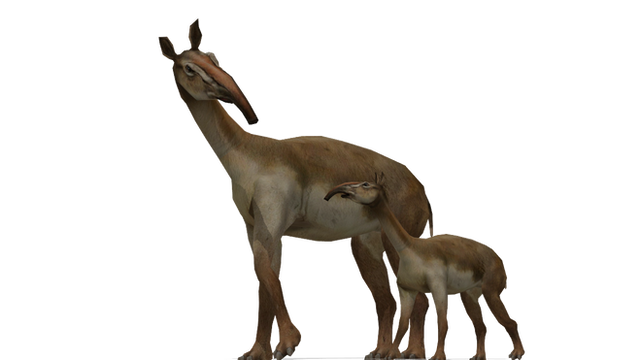HOME | DD
 Yapporaptor97 — Camelops Profile
Yapporaptor97 — Camelops Profile

#3dart #america #american #blender #camel #camels #character #digitalart #extinctanimals #extinction #iceage #paleoart #pastmeetspresent #photoshop #profile #camelids #camelops #paleoartist #pleistocenemegafauna #camelopshesternus #americanmegafauna #quaternaryextinction #characterdesign #megafauna #paleontology #pleistocene #storytelling #extinctmammals #palaeoillustration #iceagemammals
Published: 2021-06-01 14:36:35 +0000 UTC; Views: 10746; Favourites: 71; Downloads: 4
Redirect to original
Description
Camelops hesternusCamelids are among the hardiest creatures around today. With wild Bactrian camels thriving in regions like the Gobi Desert of Mongolia and China, feral and invasive Dromedaries were introduced to the Outback of Australia. In the new world, the vicuña and guanaco thrive in the highlands across South America. However, as little as 11,000 years ago, the new world was home to three more species of camels and the largest and most widespread was Camelops hesternus.
Evolution:
Camels evolved in North America around 50,000,000 years ago. They migrated over the Beringian land bridge throughout the Cenozoic and colonized the rest of the Old World. However, back in America, they had taken on many forms and occupied many niches in the new world. From larger and more robust versions of modern camels like Titanotylopus to the giraffe-like Aepycamelus. Camels of the new world are among the most well understood of all prehistoric camelids. However, by the end of the Pleistocene, only one genus of camel was left in their native homeland, Camelops.
Description:
In terms of what these camelids looked like, they were around the same size (dimension wise) as modern Bactrian Camels, however, it was slightly lighter than the domesticated two-humped camels. As far as other differences, they had a slightly longer snout that had a more uniform facial structure as there was no downturn/kink on the snout from the orbits to the nares.
As far as whether or not Camelops had humps is not known. However, if they had humps, they likely had two as DNA studies done on Dromedary and Bactrian camels indicate that one-humped camels evolved from two-humped camels.
Hump or None:
From studying the teeth of this animal, we know that Camelops was predominantly a grazer, but it could have been a browser as well. With many paleontologists agreeing that Camelops was primarily a grazer with some browsing tendencies. Similar in nature to the Bactrian camel, and unlike Dromedary camels which are predominantly browsing animals.
Range:
It ranged across America with fossils found as far north as Alaska and as far south as southern Mexico. Much like its range, it was able to adapt to a variety of habitats with these camelids able to adapt to a multitude of environments across North America. From mammoth steppe in the Yukon and scattered woodlands and plains near the Rocky Mountain foothills and the scrubland and canyonlands of Nevada, Mexico, and Arizona, to the temperate wetlands of the American South. Its broad diet would have enabled it to consume a variety of grasses and plants across its habitats, from sagebrush, Osage oranges, sedge grass, pines trees, and oak trees.
Some paleontologists have theorized that in the scrubland of Nevada and Arizona, Camelops would have controlled the range of toxic plants such as creosote bushes. Today those bushes are found across the American Southwest, and Camelops would have been the only animal that could have processed the plant.
Habitat and Contemporaries:
This animal would have lived alongside a variety of megafaunal mammals including horses, bison, and a variety of elephant and ground sloth species that thrived in the new world. If one were to time travel back to this period, they would encounter an environment that would have resembled the modern-day Serengeti of Africa.
It would have been hunted by the legendary Saber-Toothed Cat, Smilodon, the American Lion, Dire Wolf, and occasionally, the giant Short-Faced Bear.
Extinction:
It along with many other species of megafauna went at the end of the Pleistocene around 10,000 years ago. The cause of extinction is debated, but likely down to overhunting by the Clovis Paleo-Indians and climate change. Fossils analyzed in 1984 show evidence of human butchery dated to around the time Clovis Indians were present in the new world from around 13,000 to 10,000 years ago.
However they went extinct, all that remains of these American camels are fossils found across America. Today, the guanaco and vicuña are the only camelids that thrive in the new world.
___________________________________________________________________________________________
Okay, this was an animal I've wanted to do for a while.
I mainly took a dromedary camel, smoothed out the hump, made the head neck a bit longer, and corrected its posture. I tried to give it two humps but ultimately gave up because the structure of the back only allowed me to accurately mesh one hump.
In terms of its color scheme, I took inspiration from PhilipEdwin 's Camelops restoration, took AD's base camel skin, altered the colors using various adjustment layers in photoshop, and BOOM, a great Camelops skin. I did not just copy and paste the skin onto this.
Camelops hesternus by PhilipEdwin on DeviantArt
As far as if this is going to be in Past Meets Present, maybe. I'm still debating on one of the locations I'll go to for season 2. Definitely not going to be in season 1 as I've got all the locations ironed out. However, it'll probably just be a background animal or at best have one scene with the main character(s). So don't expect much from this camelid. Still glad I was able to show it.
Original animal by Triceraptor Rex and OkeanosSaviour :
Dromedary Camel (Aurora Designs) | ZT2 Download Library Wiki | Fandom
For Past Meets Present:
Past Meets Present (Pt4 is Up) - The ZT2 Round Table
Related content
Comments: 6

👍: 0 ⏩: 0

👍: 0 ⏩: 1

👍: 0 ⏩: 0

👍: 1 ⏩: 0

👍: 1 ⏩: 1

👍: 1 ⏩: 0




















